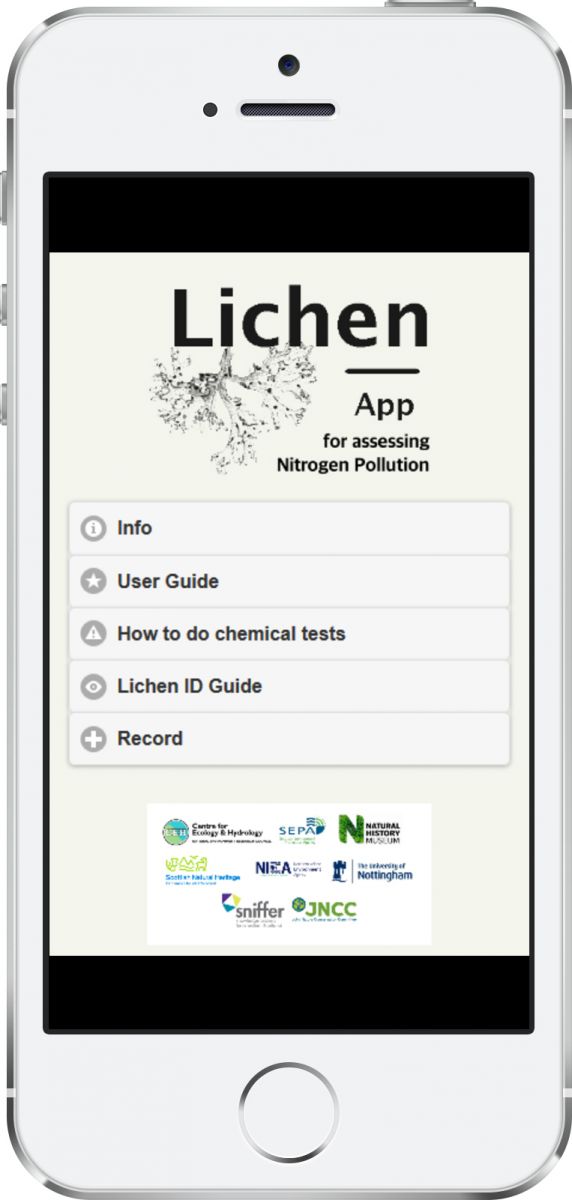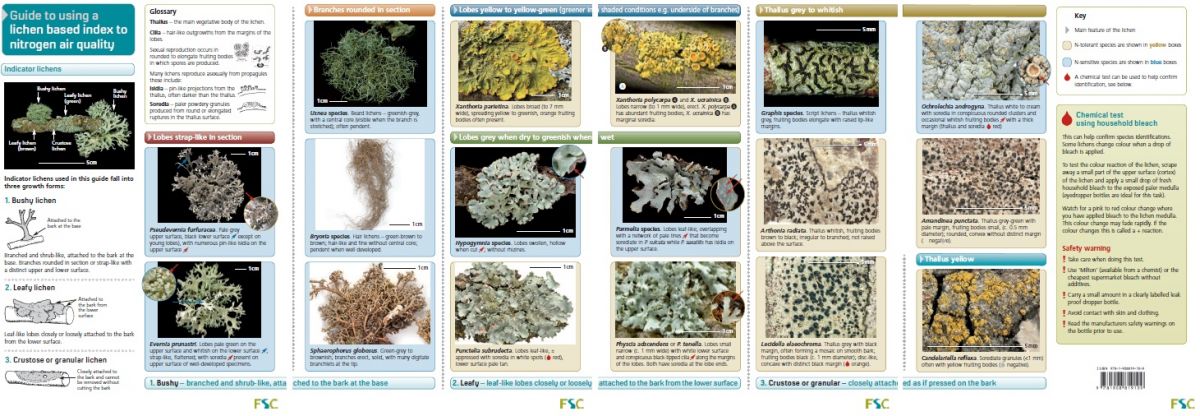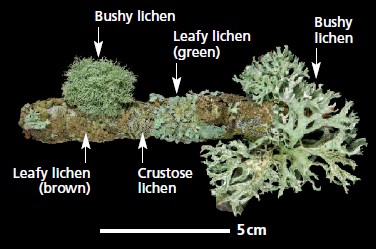 Lichen-app
Lichen-app
A new mobile app (download in the sidebar) using lichens to assess atmospheric nitrogen pollution effects has been developed by the Centre for Ecology & Hydrology (CEH). The app includes some simple elements:
- Lichen identification key guide for nitrogen sensitive and tolerant species.
- Simple Recording system for surveying lichens on tree trunks and branches
- Field guide with instructions on carrying out the survey.
- Auto-calculated and robust method to determine nitrogen pollution levels using a standardised nitrogen air quality index (NAQI).
- Informs the public of their local nitrogen air quality based on four pollutant zones - 'Clean', 'At risk', 'Nitrogen Polluted’ or 'Very Nitrogen Polluted'.
Field guide
The web-app is based on a field guide produced in collaboration with Natural History Museum, The University of Nottingham, SNIFFER, JNCC, SNH, SEPA and NIEA, and published by the Field Studies Council. The field guide for using epiphytic lichens to assess atmospheric nitrogen pollution effects on habitats is based on research. Accompanying the guide is a field manual which provides further information in support of the guide as well as recording sheets.

Lichens and nitrogen pollution
In the 1980-1990’s the impact of atmospheric nitrogen (mainly ammonia) especially from intensive animal husbandry units (poultry, pigs, dairy) on epiphytic (growing on trees) lichens was recognised.
A number of studies have assessed the effects of ammonia on epiphytic lichens (van Herk 1999; Wolseley et al. 2004, 2006; Leith et al. 2005).
In addition to ammonia, emissions of nitrogen oxides from traffic contribute to atmospheric nitrogen and several papers have shown that lichens respond to nitrogen from this source (Davies et al. 2007, Seed et al. 2013).
This research on epiphytic lichens and their response to atmospheric N-pollutants has shown that two functional species groups can be identified: lichens that are sensitive (N-sensitive) to increasing N and those that are tolerant (N-tolerant) of increasing nitrogen.
The Lichen field guide
 The 8-page fold-out guide provides a simple and robust step by step method to determine levels of risk to a habitat from gaseous N pollution by calculating a nitrogen air quality index (NAQI).
The 8-page fold-out guide provides a simple and robust step by step method to determine levels of risk to a habitat from gaseous N pollution by calculating a nitrogen air quality index (NAQI).
A recent survey (http://etheses.nottingham.ac.uk/3573/) recorded lichen frequency on the trunks and branches of two acid-barked tree species (oak and birch) at locations where atmospheric ammonia concentrations are monitored over a wide range of conditions throughout the UK and Northern Ireland.
Analysis of the data showed a good correlation of N-sensitive lichen distribution with low ammonia concentrations and of N- tolerant lichen distribution with high ammonia concentrations. From this survey a short list was created of both N-sensitive and N-tolerant indicator lichen species which non-lichen specialists could easily identify.

A lichen indicator score (LIS) is first calculated using the presence or absence of N-sensitive and N-tolerant lichen species on either trunks or branches of oak or birch at any given location. Using the LIS score an indication of air quality at a given site can be determined from the graph provided in the lichen guide.
The 8-page fold-out ‘Guide to using a lichen based index to nitrogen air quality’ was produced in collaboration with the Field Studies Council and is available as a hard copy or as a pdf attached below.
Lichen field Manual
A field manual is now available below which provides additional information on the use of the field guide, lichen identifications and a recording form and worked examples.
Links and Additional information
Davies, L., Bates, J. W., Bell, J. N. B., James, P. W., Purvis, W. O. 2007: Diversity and sensitivity of epiphytes to oxides of nitrogen in London. - Environmental Pollution 146(2): 299-310.
Seed,L., Wolseley, P., Gosling, L., Davies, L & Power, S. 2013 Modelling relationships between lichen bioindicators, air quality and climate on a national scale: Results from the UK OPAL air survey. Environmental Pollution
Wolseley, P.A., James, PW., Sutton, M.A., Theobald, M.R. (2004). Using lichen communities to assess changes in sites known ammonia concentrations. In Wolseley, P.A., Lambley,P.W (eds). Lichens in a Changing Pollution Environment. English Nature Workshop. Pp89-98. English Nature Reports. No 525 [ISSN 0967-876X]
Wolseley, P., James, P. W., Theobald, M. R., Sutton, M. A. 2006: Detecting changes in epiphytic lichen communities at sites affected by atmospheric ammonia from agricultural sources. - Lichenologist 38(2): 161-176.
